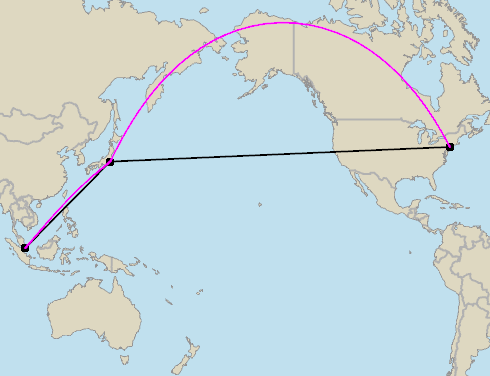GreatCircleOperator Class
Inserts extra nodes into line features and polygon features, to make the edges follow great-circle routes.
NuGet/Assembly: Carmenta.Engine.5.17.0.nupkg (in the CEOperators assembly)
Syntax
public class GreatCircleOperator : UnaryOperatorRemarks
There is a map configuration sample edit_great_circle_route.px that demonstrates how GreatCircleOperator can be used to make an editable great-circle route.
This operator takes line features and polygon features and will, along each edge, insert intermediate nodes that form a great-circle route (shortest route) between the two original edge nodes. Input features that are neither lines nor polygons will pass through unchanged.
 |
The operator will always reproject input lines and polygons to Crs.Wgs84LongLat, and compute the great-circle segments on the WGS84 ellipsoid. The output features will be in Wgs84LongLat.
To improve speed, the operator can sometimes refrain from generating output that would be outside the view area – in other words, the output can be clipped. However, the internal clipping area is larger than the view area. If your visualization needs to place a symbol or text where the great-circle route meets the view edge, it is usually enough to let PointVisualizer.ClipToViewArea be True.
Accuracy
The operator chooses its absolute accuracy to fit the view scale: the position error for any intermediate node will be less than half a screen pixel, and the distance between the intermediate nodes will be approximately 15 screen pixels, so that curved lines will look smooth. (The great-circle route can sometimes look angular where the view projection is really bad, say less than 20 km from a pole in Mercator, but it will look smoother if you zoom in.)
If you need greater control of the great-circle generation, your application can call the Crs.Route method instead. However, the operator is much easier to use than the route method, if you only want to display the result.
If you do not use the operator just for display, but call GreatCircleOperator.getFeatures(crs) without any FeatureQuery parameter, then the operator does not know what accuracy you need. The default behavior then gives a result where the points may be displaced by up to 0.5 meters, and the distance between points will usually be about 10 km, but if the crs parameter uses a cylindrical projection in equatorial aspect (like LongLat or Mercator), then the distance between points will be shorter at high latitudes. If this default is too inaccurate or generates too many points, call the Crs.Route method instead.
To learn how make an editable great-circle route, see the sample file edit_great_circle_route.px among the Carmenta Engine Configuration Samples.
Inheritance Hierarchy
System.Object
EngineObject
Operator
UnaryOperator
GreatCircleOperator
Platforms
Windows, Linux, Android
GreatCircleOperator Members
The GreatCircleOperator type has the following members.
Constructors
| Name | Description |
|---|---|
| GreatCircleOperator | Initializes a new instance of the GreatCircleOperator class. |
Properties
| Name | Description |
|---|---|
| Description | Gets or sets a short description of the operator. Inherited from Operator |
| DisplayName | Gets or sets a display name for the operator. Inherited from Operator |
| Input | Gets or sets the input operator, from which this operator reads features. Inherited from UnaryOperator |
| IsDisposed | Gets a value that tells whether the current GreatCircleOperator has been disposed. Inherited from EngineObject |
| IsoMetadataDocument | Gets or sets the path to an ISO 19139 metadata document for the operator. Inherited from Operator |
| Name | Gets or sets the name of the operator. Inherited from Operator |
| NativeHandle | Gets the native Carmenta Engine kernel object the current GreatCircleOperator represents. Inherited from EngineObject |
| IUserProperties.UserProperties | Gets the AttributeSet that contains the user properties. Inherited from IUserProperties |
Methods
| Name | Description |
|---|---|
| Clone | Creates a copy of an object. Inherited from EngineObject |
| Dispose | Releases the reference to the native Carmenta Engine kernel instance the EngineObject represents. Inherited from EngineObject |
| Equals | Determines whether this instance is equal to another. Inherited from EngineObject |
| FindChildObject | Overloaded. Finds the child object with the specified name. Inherited from Operator |
| FlushCache | Removes the objects that have been cached by the operator. Inherited from Operator |
| GetChildObjects | Overloaded. Gets the child objects of the current object. Inherited from Operator |
| GetFeatures | Overloaded. Gets features from the operator chain. Inherited from Operator |
| GetLocalizedDescription | Gets a localized version of the operator description in a specific language. Inherited from Operator |
| GetLocalizedDisplayName | Gets a localized version of the operator display name in a specific language. Inherited from Operator |
| GetLocalizedIsoMetadataDocument | Gets the path to an ISO 19139 metadata document for a specific language. Inherited from Operator |
| GetRasterFeature | Overloaded. Gets raster features from the operator chain and merges them into a single raster. Inherited from Operator |
| HasLocalizedDescription | Checks if a localized version of the operator description is available in a specific language. Inherited from Operator |
| HasLocalizedDisplayName | Checks if a localized version of the operator display name is available in a specific language. Inherited from Operator |
| HasLocalizedIsoMetadataDocument | Checks if an ISO 19139 metadata document is available for a specific language. Inherited from Operator |
| SetLocalizedDescription | Sets a operator description in a specific language. Inherited from Operator |
| SetLocalizedDisplayName | Sets a operator display name in a specific language. Inherited from Operator |
| SetLocalizedIsoMetadataDocument | Sets the path to an ISO 19139 metadata document for the operator, for a specific language. Inherited from Operator |